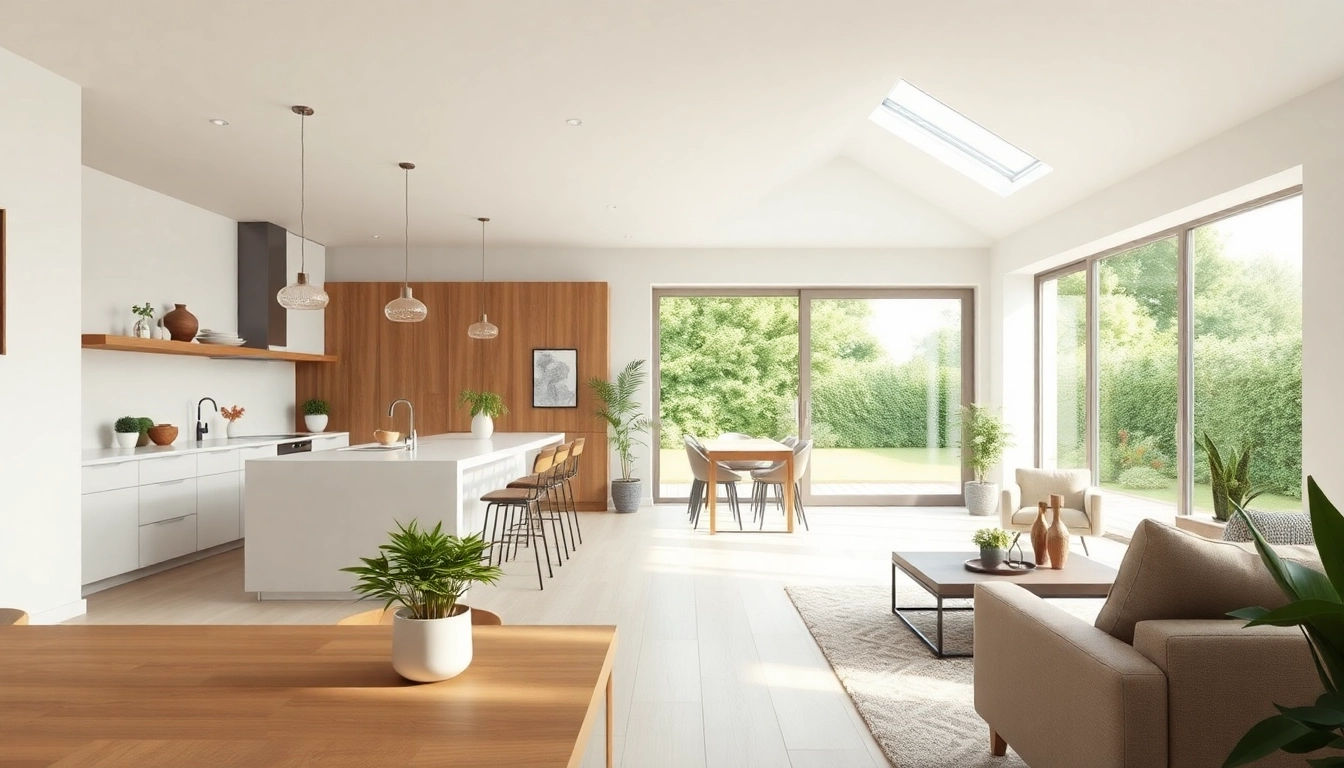Understanding Residential Extensions
Definition and Purpose
Residential extensions, commonly known as home additions, involve modifying existing homes to increase their living space. These alterations can provide essential improvements tailored to family needs, lifestyle changes, or financial aspirations. Whether you are looking to create an extra bedroom, expand your kitchen, or even add a home office, residential extensions serve the purpose of maximizing your home’s potential and enhancing its overall value. In addition, extensions can enable homeowners to adapt to changing family dynamics, offering a cost-effective alternative to moving house.
Types of Residential Extensions
Residential extensions come in various styles and types to fit different aesthetics, requirements, and budget ranges. Here are some prevalent types:
- Single-Storey Extensions: Often built at the rear or side of a house, these are ideal for expanding living areas like kitchens or family rooms.
- Two-Storey Extensions: Offering additional space on both the ground and upper floors, these extensions are suitable for larger families needing more bedrooms and bathrooms.
- Wrap-Around Extensions: Combining both rear and side extensions, this design maximizes space and light, creating cohesive open-plan living areas.
- Loft Conversions: This type of extension utilizes existing loft space to create additional bedrooms or studies while maintaining the charm of the original architecture.
- Basement Conversions: A popular choice in urban settings, it transforms the basement into usable living space, adding significant square footage without impacting outdoor areas.
- Garage Conversions: Repurposing a garage can free up essential space for additional rooms while often requiring minimal new construction.
Benefits of Extending Your Home
Extending your home comes with a multitude of advantages:
- Increased Space: More room can mean more comfort, accommodating family growth or creating special-purpose areas.
- Enhanced Property Value: A well-designed extension can add significant value to your property, making it more attractive to potential buyers.
- Customization: Homeowners have control over design choices and materials, allowing for personalized living environments that reflect their unique styles.
- Cost-Effective: Compared to moving, extensions can often be a more economical way to achieve the space you need, especially in property markets where moving costs are high.
- Minimal Disruption: With residential extensions, you can remain in your home throughout the building process, maintaining your established environment.
Planning Your Residential Extension
Identifying Your Needs
Before embarking on a residential extension project, it’s essential to evaluate your specific needs. Considerations might include the purpose of the extension, how it fits into your daily life, and the long-term benefits:
- Do you need extra bedrooms, or would a larger kitchen suit your family better?
- Are you looking to create an office space, or do you need a play area for children?
- Assess how much space you truly need, taking into account potential future needs as well.
Legal Considerations and Permits
Engaging with local regulations and obtaining the necessary permits is an important aspect of planning your residential extension. Here are the key legal frameworks to consider:
- Planning Permission: Most extensions require planning permission from your local council, especially if they alter the structure’s exterior significantly.
- Building Regulations: These regulations ensure the construction is safe and environmentally compliant; they cover everything from structural integrity to safety standards.
- Conservation Areas or Listed Buildings: If your property is in a conservation area or is listed, you may face additional restrictions on what can be done.
Budgeting and Financial Analysis
Creating a realistic budget is vital for the successful completion of your extension. Consider all potential costs:
- Construction Costs: This includes labor, materials, and potential design fees.
- Permitting Fees: Budget for any fees associated with obtaining necessary permissions.
- Hidden Costs: Account for contingencies, unexpected site conditions, or changes in project scope that may arise during construction.
- Financing Options: Explore various financing methods such as home equity loans or additional mortgage financing if needed.
Design Ideas for Stunning Extensions
Popular Styles and Trends
The design of your residential extension should complement the existing style of your home while also being functional. Here are some popular design ideas and current trends:
- Seamless Transitions: Creating a smooth visual transition between old and new, often achieved through materials and color schemes that blend with existing structures.
- Open-Plan Living: This trend focuses on removing traditional boundaries within spaces, enhancing social interactions and light flow.
- Biophilic Design: Incorporating natural elements such as plants and natural light; large windows or skylights are common in this design style.
- Eco-Friendly Solutions: Utilizing sustainable materials and energy-efficient designs to minimize environmental impact while maximizing comfort.
- Smart Home Technology: Integrating technology into the design, such as smart thermostats and automated lighting, for improved efficiency and convenience.
Maximizing Natural Light
Natural light can significantly enhance the aesthetics and ambiance of your home. Implement strategies like:
- Large Windows: Installing large picture windows or sliding glass doors can create an open feel while flooding your spaces with light.
- Skylights: These are excellent for adding brightness in areas that don’t have exterior walls, such as bathrooms or hallways.
- Light Wells: For basement conversions or darker areas, light wells can introduce sunlight and improve air circulation.
Integrating with Existing Architecture
Maintaining cohesiveness with the original structure is crucial in home extensions. Tips for successful integration include:
- Design Consistency: Match architectural details such as windows, roofs, and siding with the existing structure.
- Material Choices: Use similar materials to the original house to blend the extension seamlessly.
- Architectural Style: Consider whether your home is modern, traditional, rustic, or another style, and select designs accordingly.
Construction Process for Residential Extensions
Selecting the Right Contractors
Choosing the right contractors is a key component in the extension process. Considerations include:
- Experience: Look for contractors with a strong portfolio in residential extensions and positive client reviews.
- Specialization: If your project involves unique challenges (e.g., basement work or eco-friendly materials), select contractors who specialize in those areas.
- Licensing and Insurance: Verify that potential contractors have the necessary licenses and insurance to protect you during construction.
Managing Timelines and Expectations
Having a clear timeline and set expectations helps maintain progress throughout the construction phase. Consider the following:
- Clear Communication: Keep an open line of dialogue with your contractors and regularly assess progress against the planned timeline.
- Realistic Goals: Accept that unforeseen delays can occur due to weather, permit delays, or material shortages; factor in additional time in your planning.
- Quality Control: Regularly inspect work during construction to ensure standards are met and any issues are addressed promptly.
Common Challenges and Solutions
Residential extensions can come with challenges, but proactive planning can help mitigate most issues. Common challenges include:
- Site Limitations: If space is restricted, consider vertical solutions like multi-storey extensions or loft conversions.
- Budget Overruns: Implement stringent budgeting practices and contingency planning to anticipate potential extra costs.
- Disruption: Prepare a plan for managing household disruption during construction, including temporary living arrangements if needed.
Maximizing the Value of Your Extension
Design Features that Add Value
Features that not only enhance aesthetics but also contribute to financial value include:
- High-Quality Materials: Investing in premium materials translates to longevity and appeal in the eyes of prospective buyers.
- Energy Efficiency: Install energy-efficient heating, cooling, and insulation systems to attract eco-conscious buyers and reduce living costs.
- Functional Spaces: Create versatile spaces that can adapt to evolving needs, such as home offices or guest suites.
Increasing Energy Efficiency
Enhancing energy efficiency through your extension can lead to substantial savings and increased property value:
- Proper Insulation: High-quality insulation in walls and roofs reduces heating and cooling costs.
- Energy-Efficient Windows: Double or triple-glazing effectively minimizes heat loss.
- Renewable Energy Options: Consider integrating solar panels to cover energy needs and appeal to environmentally-minded homeowners.
Future-Proofing Your Residential Extension
Consider design factors that maintain flexibility for future needs:
- Modular Designs: Incorporate designs that allow for easy modification or expansion in the future as family needs change.
- Smart Home Technology: Embrace technology that adapts over time, such as smart thermostats and security systems that can evolve with advancements.
- Sustainable Practices: Choose materials and designs that promote sustainability, making them more attractive as eco-conscious norms continue to evolve.
Residential extensions are a valuable way to enhance living space, increase property value, and customize your home. By understanding needs, planning effectively, engaging the right professionals, and considering sustainable and energy-efficient options, you can create an extension that adds significant value to your home. For insightful guidance on residential extensions, understanding local building regulations is crucial for a successful outcome. So whether you’re planning a minor revamp or a major renovation, the keys to success lie in proper planning, design, and execution.




